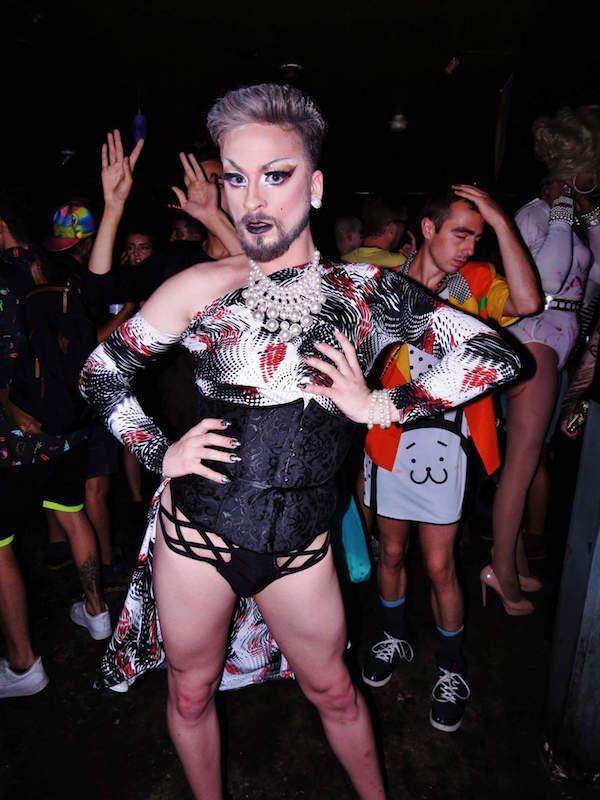"Draglesque boyqueen" Vic Sin. Photo courtesy of Sin by Dmitri Wildfong-Nishman.
Photo courtesy of Vic Sin by Cameron Cole
K.James perfoms his "Cream" act. Photo courtesy of K.James by Grace Chu.
The attitude in this new performance scene does seem to imply that everyone is indeed a special snowflake, that there are a million genders—and that there's nothing wrong with that."Performers are not focusing on 'boy' or 'girl' anymore. It's about expression," says Vic Sin, the draglesque boyqueen, putting the shift into words "You could be Beetlejuice, a dog, a troll, a witch—performers are pushing the boundaries of expression. I don't relate to guy or girl in my looks. I feel fem, strong, masculine, sexy, kinky. I don't do 'norm.'"Devonne agrees with Sin's sentiments. "I have seen cisgender performers perform routines, original creations, and cosplay to popular entertainment icons," Devonne says of the variety he's witnessed. "I've seen trans individuals perform drag in the [gender] role of [which] they were assigned [at birth] but do not identify— which naturally creates something of a fascinating, unspoken commentary on what we might assume a person is all about, gender-wise. I've seen nonbinary performers give us four-minute explorations into what they've been meditating on for years," he tells me with an air of admiration for it all. "It is really all very fabulous. And we've been very blessed with an audience that wants to see it and support it."I've seen nonbinary performers give us four-minute explorations into what they've been meditating on for years.

Photo courtesy of Goldie Peacock by Suri
Photo courtesy of Nyx Nocturne by Elisabeth Fuchsia
"Everything about it is intense, and outrageous," she remarks of her act. "Some people see it as a priest act only, but I see it as a genderfucking act." According to Nocturne, her act is even more than performance. "It's really what's in my soul and feels like me. It doesn't necessarily put me in the confines of having to be sexy in a certain way, and it lets me show a side of me I don't often get to show."This new genderplay finds challenges, too, in the world of what Crimson Kitty calls "ladyqueens"— cis-born women who perform as female drag queens. Kitty's heart and mission lie in female drag, but the drag scene at large hasn't always accepted what she does. In the past, ladyqueens have been accused of co-opting the gay cis-male drag scene.Nocturne soon discovered that she felt most powerful, and comfortable, with a character she created called Andro-Royalty, which is not a drag king or a drag queen, but "in the middle of and between those two spaces."
Though the ladyqueen, or bioqueen, is not a new fixture (World Famous BOB, Dr. Lucky, and Raven Snook are the stars of a 2010 ladyqueen documentary called The Faux Real), Kitty is determined to carve out a scene for those of her ilk looking for community, and she's educating the public in the process. Kitty is currently producing a new show, aptly titled Ladyqueen, at the famous Stonewall Inn, as well as planning a nationwide tour and an education panel."It's all about education," Kitty says about why she's embarking on this work. "I want people to ask questions, to have a great dialogue—and not necessarily a defensive one—about women doing drag, but not as drag kings. I want to educate people on how we are breaking down our own gender boundaries by exploring a hyper feminized version of ourselves."Devonne, the gender-blending burlesque performer, sees a world in which drag and genderplay performers accept one another as unique. "I have seen a lot of drag that goes beyond the conventional [RuPaul] Supermodel of the World mold, and I'm all for it," he says. "I think men in makeup are beautiful. I think women in makeup are beautiful. I actually really love makeup itself." He adds, "I think it's incredibly bold to choose the face you wear, and I don't think it's at all a mask or a hiding place. I think it's one of the greatest statements of self-identification."Watch: Meet London's Female Queens